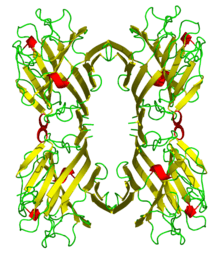Phytohaemagglutinin
| Legume lectin domain | |||||||||
|---|---|---|---|---|---|---|---|---|---|
 | |||||||||
| Identifiers | |||||||||
| Symbol | Lectin_legB | ||||||||
| Pfam | PF00139 | ||||||||
| Pfam clan | CL0004 | ||||||||
| InterPro | IPR001220 | ||||||||
| PROSITE | PDOC00278 | ||||||||
| SCOP | 1lem | ||||||||
| SUPERFAMILY | 1lem | ||||||||
| |||||||||
Phytohaemagglutinin (PHA, or phytohemagglutinin) is a lectin found in plants, especially legumes. PHA actually consists of two closely related proteins, called leucoagglutinin (PHA-L) and PHA-E. The letters E and L indicate these proteins agglutinate Erythrocytes and Leukocytes. Phytohaemagglutinin has carbohydrate-binding specificity for a complex oligosaccharide containing galactose, N-acetylglucosamine, and mannose.[2]
It is found in the highest concentrations in uncooked red kidney beans and white kidney beans (also known as cannellini),[3] and it is also found in lower quantities in many other types of green beans and other common beans (Phaseolus vulgaris), as well as broad beans (Vicia faba) such as fava beans.[4] It has a number of physiological effects and is used in medical research. In high doses, it is a toxin.
The lectin has a number of effects on cell metabolism; it induces mitosis, and affects the cell membrane in regard to transport and permeability to proteins. It agglutinates most mammalian red blood cell types.
As a toxin, it can cause poisoning in monogastric animals, such as humans, through the consumption of raw or improperly-prepared kidney beans. Measured in haemagglutinating units (hau), a raw red kidney bean may contain up to 70,000 hau. This can be reduced to safe levels by correct cooking (boiling for at least 30 minutes at 100 °C/ 212 °F).[5] Insufficient cooking, such as in a slow cooker at 80 °C/ 176 °F, however, can increase this danger and raise the available hau up to fivefold.[6] Beans also contain alpha amylase inhibitor, but not in sufficient quantities to affect the digestion of starch after consumption of beans.[7]
Poisoning can be induced from as few as five raw beans, and symptoms occur within three hours, beginning with nausea, then vomiting, which can be severe and sustained (profuse), followed by diarrhea. Recovery occurs within four or five hours of onset, usually without the need for any medical intervention.
In medicine these proteins are useful and are used as a mitogen to trigger T-lymphocyte cell division and to activate latent HIV-1 from human peripheral lymphocytes. In neuroscience, anterograde tracing is a research method that uses the protein product phytohaemagglutinin PHA-L as a molecular tracer that can be taken up by the cell and transported across the synapse into the next cell thereby tracing the path of axonal projections and relative connections that nerve impulses travel beginning with the source located at the perikaryon (cell body or soma) and through the presynaptic part located on neuron's efferent axon all the way to the point of termination at the efferent synapse which then provides input to another neuron.[8]
Lymphocytes cultured with phytohaemagglutinin can be used for karyotype analysis.
History
PHA was discovered by Dr. Peter Nowell, codiscoverer of the Philadelphia chromosome in the 1960s.
References
- ↑ Hamelryck, T. W.; Dao-Thi, M. H.; Poortmans, F.; Chrispeels, M. J.; Wyns, L.; Loris, R. (1996). "The crystallographic structure of phytohemagglutinin-L". The Journal of Biological Chemistry 271 (34): 20479–20485. doi:10.1074/jbc.271.34.20479. PMID 8702788.
- ↑ "PHA-E specification sheet Medicago AB: Phytohaemagglutinin" (PDF). Retrieved 2010 Mars 14. Check date values in:
|access-date=(help) - ↑ "Kidney Beans". The world's healthiest foods. Retrieved 2007-11-05.
- ↑ "Bad Bug Book (2012)" (PDF). Foodborne Pathogenic Microorganisms and Natural Toxins Handbook: Phytohaemagglutinin. United States Food and Drug Administration. p. 254. Retrieved 2013-12-27.
- ↑ "Bad Bug Book (2012)" (pdf). Foodborne Pathogenic Microorganisms and Natural Toxins Handbook: Phytohaemagglutinin. Food and Drug Administration. 2012. Retrieved 26 December 2013.
Consumers should boil the beans for at least 30 minutes to ensure that the product reaches sufficient temperature
- ↑ Bad Bug Book (2009). "Foodborne Pathogenic Microorganisms and Natural Toxins Handbook Phytohaemagglutinin". US Food and Drug Administration. Retrieved 26 December 2013.
- ↑ Layer P, Carlson GL, DiMagno EP. Partially purified white bean amylase inhibitor reduces starch digestion in vitro and inactivates intraduodenal amylase in humans. Gastroenterology. 1985 Jun;88(6):1895-902.
- ↑ Carlson, Neil R. (2007). Physiology of Behavior, 9th ed. Boston: Pearson Education, Inc. p. 144. ISBN 0-205-46724-5.
External links
- Phytohemagglutinins at the US National Library of Medicine Medical Subject Headings (MeSH)
| ||||||||||||||||